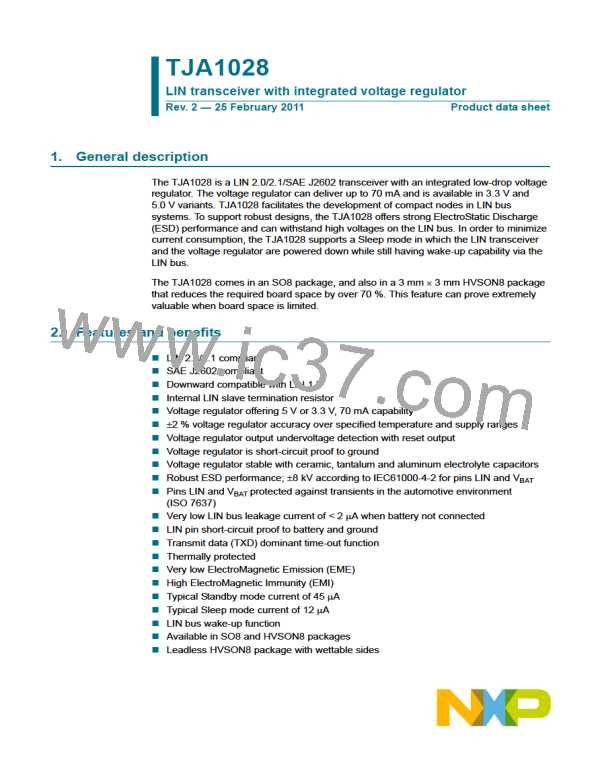TJA1028
NXP Semiconductors
LIN transceiver with integrated voltage regulator
The TJA1028T/xxx/20 and TJA1028TK/xxx/20 versions are optimized for a speed of
20 kBd, the maximum specified in the LIN standard. The TJA1028T/xxx/10 and
TJA1028TK/xxx/10 versions are optimized for a transmission speed of 10.4 kBd, as
specified in SAE J2602.
7.1 Operating modes
The TJA1028 supports four operating modes: Normal, Standby, Sleep and Off. The
operating modes, and the transitions between modes, are illustrated in Figure 3.
AII states
V
BAT
< V
OR
th(det)poff
T
> T
th(act)otp
vj
remote
wake-up
V
BAT
T
> V
th(det)pon AND
th(rel)otp
EN = 1 AND
RSTN = 1
< T
vj
OFF
LIN = off
STANDBY
LIN = off
(1)
NORMAL
RXD = floating
RSTN = LOW
LIN = on
(RXD signals
wake source)
EN = 1 0 AND
TXD = 1 AND
RSTN = 1
(3)
EN = 1
0 AND
TXD = 0 AND
RSTN = 1
EN = 1
(3)
wake-up
event
SLEEP
LIN = off
Voltage regulator - on
Voltage regulator - off
(2)
RXD = V
RSTN = LOW
CC
015aaa086
(1) In Normal mode, the LIN transmitter is enabled - but if EN and/or RSTN go LOW, the LIN
transmitter will be disabled. Remote wake-up signalling will be activated.
(2) Until VCC drops below 2 V.
(3) If a wake-up event and a go-to-sleep event occur simultaneously, the device will switch directly to
Standby mode without initiating a reset.
Fig 3. State diagram
7.1.1 Off mode
The TJA1028 switches to Off mode from all other modes if the battery supply voltage
drops below the power-off detection threshold (Vth(det)poff) or the junction temperature
exceeds the overtemperature protection activation threshold (Tth(act)otp).
The voltage regulator and the LIN physical layer are disabled in Off mode, and pin RSTN
is forced LOW.
7.1.2 Standby mode
Standby mode is a low-power mode that guarantees very low current consumption.
TJA1028
All information provided in this document is subject to legal disclaimers.
© NXP B.V. 2011. All rights reserved.
Product data sheet
Rev. 2 — 25 February 2011
5 of 24

 NXP [ NXP ]
NXP [ NXP ]